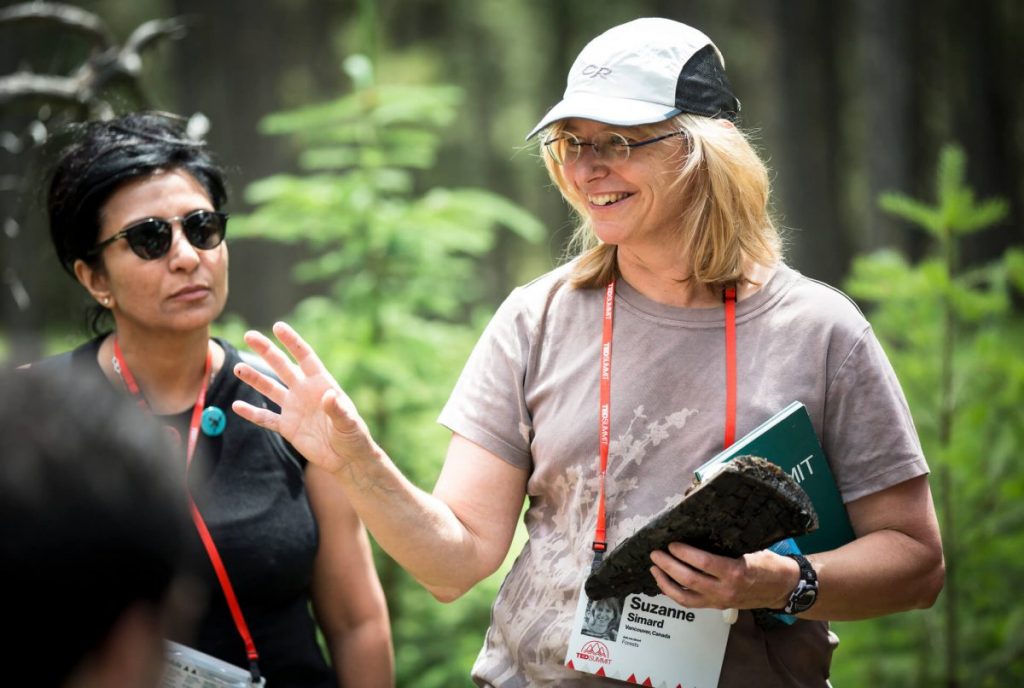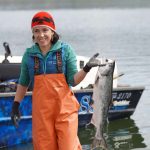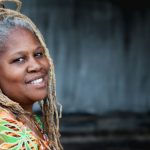
Every day Suzanne Simard walks into the forest, up switchbacks sheltered by pines, to Pulpit Rock overlooking Nelson, British Columbia. In the Selkirk Mountains this time of year, the air is crisp and she can see a bit of snow on the high peaks nearby. Needles are dropping from the conifers and drying and crunching underfoot as the dense understory morphs from green to red, yellow and orange. “The place of rejuvenation,” Simard calls it.
Simard is a professor of forest ecology at the University of British Columbia and author of Finding the Mother Tree: Discovering the Wisdom of the Forest (Knopf, 2021), a memoir about thinking unconventionally and pushing through hardships, both personal and professional, to uncover the secrets of the forest. When she’s having a tough day, Simard goes to the forest to “clear my mind, breathe in the air, speak with the trees,” she says. Besides, even on a trail she knows well, “there’s always something cool to look at,” says Simard.
The forest has always been a source of recovery and discovery for Simard, a pioneer in plant communication and cooperation. She grew up in B.C.’s Monashee Mountains—“mountains of peace” in Gaelic—feeling, seeing, even tasting its inland rainforest (her “wild child” habit of chewing roots and eating dirt required regular de-worming sessions). By tromping through cedar-hemlock old-growth forest Simard intuited that it was a complex, intertwined system but it would take decades, and a ton of persistence, to prove it.
Simard’s family grew generations of selective foresters and, as a college student in the 1980s, she took a summer job in industrial logging (one of the first women to do so). Right away she could see clear-cutting diverse forests was unsustainable and potentially disastrous. Foresters at the time believed trees competed for sun, water and nutrients, but removing conifers and deciduous trees and replanting only cash crop trees was failing to recreate healthy forests.
Simard didn’t know why—yet—but she had a growing sense that what lies beneath the forest floor, specifically its fungus, could mean life or death for a tree. “I could see it right away—as soon as you lose a bunch of species, you’re undercutting that ecosystem. So I understood that diversity was important, whereas I don’t think my male colleagues understood that at the time, at least the ones that were making policies and laws and practices and so on,” she says. “They had jurisdiction over sciences, over forestry practices, and they saw things in a very narrow, male way…it was like they could see only with one eye. And then when the female eye comes on it, we can see the broader picture.”
That emerging, unorthodox insight—and from a young woman—raised a lot of eyebrows but did nothing to slow the clear-cutting. Simard moved on to a government role where her experiments showed that trees planted, homogenously and in rows, did not connect to the soil and did not thrive. Was cooperation, not competition, the key to a tree’s survival? she wondered. And, if so, how did it work?
Despite offering evidence that diversity was critical to a forest, Simard was dismissed, excluded and often humiliated into keeping her mouth shut or moving on. As a woman, says Simard, “I had to use whatever wits I had to keep going. So I would just switch paths—that’s a survival instinct—but I never lost the drive to keep working in forests.” As women, she says, “We have to be persistent and smart and wily like coyotes—and vigilant.”
With anger, frustration and tenacity, Simard pivoted to academia, hopeful that rigorous science could prove that trees were cooperators, not solely competitors, as most people believed. You fight for what you love, she says, so Simard returned to the forest, time and again, despite sometimes perilous conditions including many grizzlies, stinging insects, searing heat/numbing cold, and experiments requiring dangerous radiation and toxic chemicals.
Her persistence has led to some astonishing discoveries. As a young researcher, Simard went down to the root level, literally, to sort out whether or not trees in a forest relied on one another, and if clear-cutting was disrupting that link. To test that theory, she injected tree saplings with rare carbon isotopes as tracers, then measured the exchange. When Simard heard the Geiger counter crackling, an indication that the trees were sharing radioactive carbon, she knew she was onto something big—that the forest was integrated in a way Western science had never before captured. (Simard regularly points out that aboriginal cultures had an understanding of these complex linkages for generations.)
Simard showed that trees in the wild exchange carbon—the energy currency of all ecosystems—via subterranean networks of beneficial fungi that colonize tree roots and connect one tree to another. Ultimately it became clear that trees, even those of different species, store and exchange not just carbon but nutrients, water and information via vast webs of mycorrhizal fungi. While the fungus delivers water and nutrients to the root systems of trees, in return, those trees supply the fungi with photosynthate (a sugar). We now know that virtually all plants and trees in forests worldwide rely on these highly evolved, tree-fungi-tree relationships. “I knew in my heart what was right from the beginning,” says Simard.
When Simard’s remarkable “wood wide web” findings were published, there was immediate pushback from established forest ecologists. But she has gone on to publish over 200 peer-reviewed articles about the vast networks and feedback loops beneath our feet. She “saw the forest for the fungus,” so to speak, and, in doing so, has changed the way we think about both. A forest is not a society of individuals competing for resources, but a community giving and taking and warning each other of imminent threats. It learns, evolves and stores knowledge using an intricate, interconnected, biological neural network similar in some ways to the human brain.
Simard is still listening to what forests have to say, and still fighting for trees, like the last remnant old-growth forests in B.C. which, like many worldwide, are now under threat. Most recently, she and her research team found that the biggest, oldest trees in a forest are root-rich hubs—what she dubbed “mother trees”—helping neighbors establish themselves and eventually contribute to a symbiotic environment. They also found that trees recognize their kin and make sure to give them a head start. Simard’s ongoing Mother Tree Project is looking at how those interactions affect forest resiliency, adaptability and recovery—particularly important given the challenges of climate change (big trees store an enormous amount of carbon, harbor immense biodiversity, and contain a wealth of genetic diversity).
The parallel between tree communities and human societies is not lost on Simard, who believes we can learn from the forest’s ancient way of thriving. “It’s showing us…how to live your life, how society can be structured.” Understanding how trees band together and endure shows us not only a way to heal forests but to heal our world. “I get overwhelmed by the work but I’ve never lost interest in it,” says Simard. “The forest is a never-ending, fascinating, lovely, life-giving place to be, and we need [it].”



